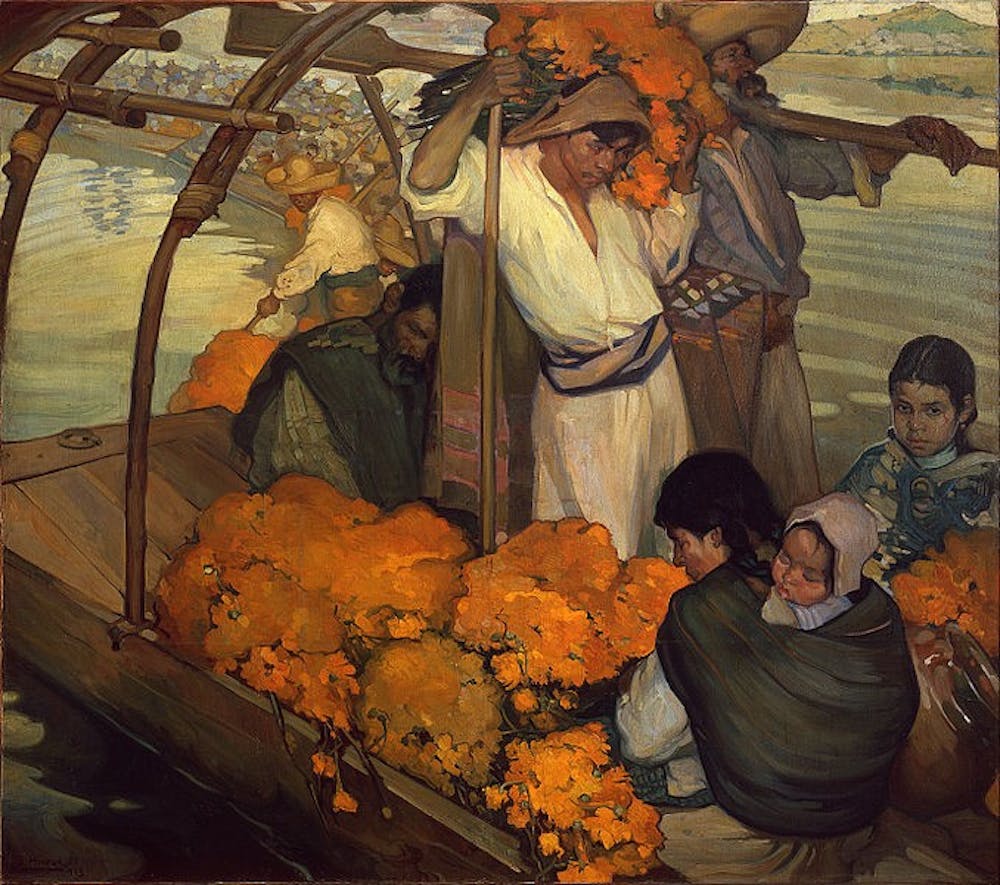The Offering, a monumental painting by Saturino Herrán, confronts you at the entrance of “Paint the Revolution: Mexican Modernism, 1910–1950,” the recently–opened show at the Philadelphia Museum of Art. Six figures and the boat they inhabit fill the frame; two men stand, another sits and rests, a woman kneels with a child strapped to her back and the last, a child, glowers out of the frame. Undulating mounds of orange marigolds pile around them and engulf them like fire. The central figure, strained under his own burden of the flowers, wears brilliant white and stands crucified by the boat’s oar.
Herrán is known for his modern approach to capturing scenes like the one in The Offering, scenes of everyday life. Marigolds, placed on altars and graves on the Day of the Dead, lay alongside individuals of all ages. The piece is a testament to the cyclical quality of life—its thick strokes of paint and mottled blocks of color add to its feeling of rushed ephemerality, its emphasis on the moment. This feeling of change, of a cyclic existence, works well to open the show. Past The Offering, you quickly become aware of change and the action of time moving forward.

Throughout the exhibition, timelines mark the history of the Mexican Revolution. Starting with the resignation of the despotic President Porifirio Díaz in 1911, the show follows closely the chronology of the tumultuous period. Pieces from early in the Revolution exhibit mexicanidad—an aesthetic distinctly Mexican in character with roots in the country’s natural landscape and traditions. This quality never really goes away; it only manifests in different ways. It can be seen in the nationalistic pieces that came out of the strong government support of the arts beginning in the 1920s and in the works of the avant-garde who sought to forge the country’s political and artistic destiny.
 Notable about the show is its commitment to the digital humanities. There was really no other choice in presenting works of the great Mexican muralists Diego Rivera, José Clemente Orozco and David Alfaro Siqueiros, though. Orozco’s The Epic of American Civilization, painted in the Baker-Berry Library at Dartmouth College, is projected as a constantly panning video on a wall deep in the gallery. Accompanying tablets allow visitors to scroll through the work and read about each part of the cycle, which details Latinx history from before the conquest of the Americas to the modern industrial age. The effect is immersive and offers a noble imitation of the real work.
Notable about the show is its commitment to the digital humanities. There was really no other choice in presenting works of the great Mexican muralists Diego Rivera, José Clemente Orozco and David Alfaro Siqueiros, though. Orozco’s The Epic of American Civilization, painted in the Baker-Berry Library at Dartmouth College, is projected as a constantly panning video on a wall deep in the gallery. Accompanying tablets allow visitors to scroll through the work and read about each part of the cycle, which details Latinx history from before the conquest of the Americas to the modern industrial age. The effect is immersive and offers a noble imitation of the real work.
Though full of monumental political pieces by “the big three” muralists and the now ubiquitous Frida Kahlo, "Paint the Revolution" offers a surprisingly intimate look into the lives of Mexican artists, too. Manuel Rodriguez Lozano and Abraham Ángel’s dual portraits of each other hang one above the other. Above is Lozano’s portrait of Ángel, who glares out sideways from the canvas against a background of blue and green scales. Below, Lozano’s sharp profile stands out against a hazy sky. The two artists were lovers and the paintings persist to memorialize their relationship; Lozano painted his portrait of Ángel after his death, the gallery description details.
The kitschy Frida paraphernalia, calavera molds and plastic wrapped papel picado of the exhibition gift shop is almost unsettling after walking through “Paint the Revolution.” It doesn’t do justice to the depth of history exhibited just a few feet prior. The show is expansive in what it presents and moving in its expansiveness. It provides a history lesson to rival anything that might be given at Penn.
Note: Admission to the PMA is free the first Sunday of every month and every Wednesday from 5–8:45 p.m.

